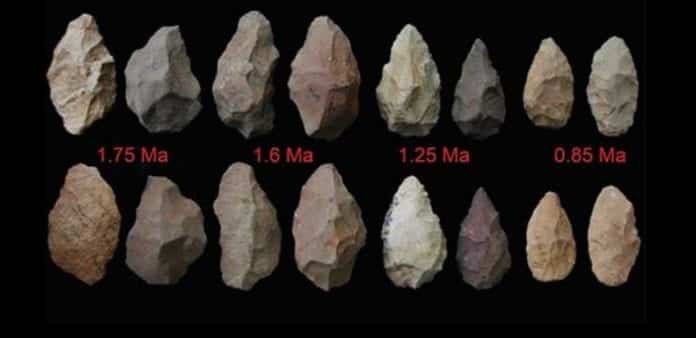Oldest human tools assumed to be 3.3 million years old discovered in Africa
Those who said technology was a recent phenomenon have to change their views.
In a recent annual meeting of the Paleoanthropology Society held in the US this week, the researchers announced the discovery of a set of stone tools in Kenya. The stone tools are touted to be the oldest ever found and are assumed to be more than 3.3 million years old making them 700,000 years older than any other tools ever found.
The significance for this is very huge, because they precede the arrival of our genus Homo, which is supposed to be 2.8 million years old. This is an indication that ancient, long-gone australopithecines such as ‘Lucy’ could have been producing and using tools long before our genus even existed.
An international team of paleontologists in 2003 discovered the oldest stone tools ever found. Believed to be 2.6 million years ago, it was extricated from the site of Gona, in the Afar triangle of Ethiopia’s Great Rift Valley. It is traced to be the earliest stone tool technology in the archaeological record, known as the Oldowan.
This technology spread widely throughout between 2.6 and 1.7 million years ago to eastern Africa and down to southern Africa. By 1.8 million years ago, early Homo populations had taken it with them to Europe, as illustrated by fossil remains and Oldowan tools found in Dmanisi, Georgia in 2002.
Thanks to archaeologist, Sonia Harmand and her colleagues from Stony Brook University in New York, we now have tools that are very, very old than the Ethiopian cache.
Michael Balter explains the find in Science Mag, which was discovered just west of Lake Turkana in Kenya, as below:
“More tools were discovered under the ground, including so-called cores from which human ancestors struck off sharp flakes; the team was even able to fit one of the flakes back to its original core, showing that a hominin had crafted and then discarded both core and flake in this spot.
The researchers have now uncovered nearly 20 well-preserved flakes, cores, and anvils apparently used to hold the cores as the flakes were struck off, all sealed in sediments that provided a secure context for dating. An additional 130 pieces have also been found on the surface, according to the talk.”
The find links into a contentious study that came out in 2010 following the discovery of a 3.4-million-year-old australopithecine child in the Ethiopian site of Dikika, together with animal bones reflecting a series of cut marks along them. These direct marks appeared to be intentional, and not just coincidental scratches. The team that was working on the discovery disputed and suggested that these ancient human ancestors were actually the tool-users. Now, with the finding of stone tools which seems to be around the same time period only adds substance to this theory.
“With the cut marks from Dikika we had the victim,” paleoanthropologist Zeresenay Alemseged from the California Academy of Science, who was not involved in the discovery, told Balter. “Harmand’s discovery gives us the smoking gun.”
Harmand told at the meeting that as the tools were in existence much before the Homogenus were discovered, they were likely to be made by members of either the Kenyanthropus or Australopithecus (Lucy) genera. The team has suggested a new word for the technology used to make these tools – “Lomekwian technology”, because the way they have been made is so specific from the Oldowan tools that have been found so far.

